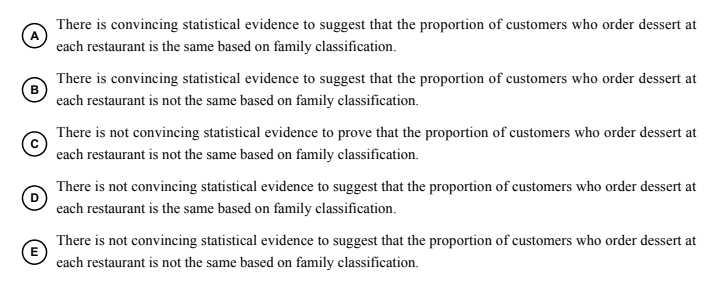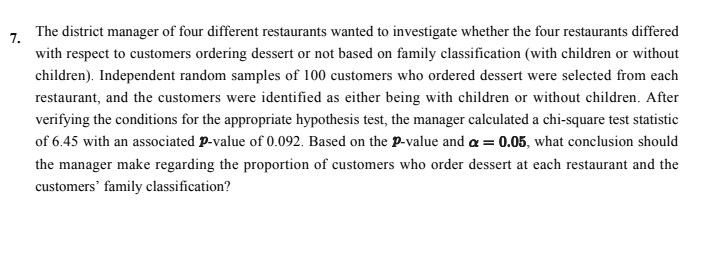The district manager of four different restaurants wanted to investigate whether the four restaurants differed with respect to customers ordering dessert or not based on family classification (with children or without children). Independent random samples of 100 customers who ordered dessert were selected from each restaurant, and the customers were identified as either being with children or without children. After verifying the conditions for the appropriate hypothesis test, the manager calculated a chi-square test statistic of 6.45 with an associated P-value of 0.092. Based on the P-value and a = 0.05, what conclusion should the manager make regarding the proportion of customers who order dessert at each restaurant and the customers' family classification?
The district manager of four different restaurants wanted to investigate whether the four restaurants differed with respect to customers ordering dessert or not based on family classification (with children or without children). Independent random samples of 100 customers who ordered dessert were selected from each restaurant, and the customers were identified as either being with children or without children. After verifying the conditions for the appropriate hypothesis test, the manager calculated a chi-square test statistic of 6.45 with an associated P-value of 0.092. Based on the P-value and a = 0.05, what conclusion should the manager make regarding the proportion of customers who order dessert at each restaurant and the customers' family classification?
MATLAB: An Introduction with Applications
6th Edition
ISBN:9781119256830
Author:Amos Gilat
Publisher:Amos Gilat
Chapter1: Starting With Matlab
Section: Chapter Questions
Problem 1P
Related questions
Topic Video
Question

Transcribed Image Text:There is convincing statistical evidence to suggest that the proportion of customers who order dessert at
each restaurant is the same based on family classification.
There is convincing statistical evidence to suggest that the proportion of customers who order dessert at
each restaurant is not the same based on family classification.
There is not convincing statistical evidence to prove that the proportion of customers who order dessert at
each restaurant is not the same based on family classification.
There is not convincing statistical evidence to suggest that the proportion of customers who order dessert at
each restaurant is the same based on family classification.
There is not convincing statistical evidence to suggest that the proportion of customers who order dessert at
(E
each restaurant is not the same based on family classification.

Transcribed Image Text:The district manager of four different restaurants wanted to investigate whether the four restaurants differed
7.
with respect to customers ordering dessert or not based on family classification (with children or without
children). Independent random samples of 100 customers who ordered dessert were selected from each
restaurant, and the customers were identified as either being with children or without children. After
verifying the conditions for the appropriate hypothesis test, the manager calculated a chi-square test statistic
of 6.45 with an associated P-value of 0.092. Based on the p-value and a = 0.05, what conclusion should
the manager make regarding the proportion of customers who order dessert at each restaurant and the
customers' family classification?
Expert Solution
This question has been solved!
Explore an expertly crafted, step-by-step solution for a thorough understanding of key concepts.
This is a popular solution!
Trending now
This is a popular solution!
Step by step
Solved in 2 steps

Knowledge Booster
Learn more about
Need a deep-dive on the concept behind this application? Look no further. Learn more about this topic, statistics and related others by exploring similar questions and additional content below.Recommended textbooks for you

MATLAB: An Introduction with Applications
Statistics
ISBN:
9781119256830
Author:
Amos Gilat
Publisher:
John Wiley & Sons Inc

Probability and Statistics for Engineering and th…
Statistics
ISBN:
9781305251809
Author:
Jay L. Devore
Publisher:
Cengage Learning

Statistics for The Behavioral Sciences (MindTap C…
Statistics
ISBN:
9781305504912
Author:
Frederick J Gravetter, Larry B. Wallnau
Publisher:
Cengage Learning

MATLAB: An Introduction with Applications
Statistics
ISBN:
9781119256830
Author:
Amos Gilat
Publisher:
John Wiley & Sons Inc

Probability and Statistics for Engineering and th…
Statistics
ISBN:
9781305251809
Author:
Jay L. Devore
Publisher:
Cengage Learning

Statistics for The Behavioral Sciences (MindTap C…
Statistics
ISBN:
9781305504912
Author:
Frederick J Gravetter, Larry B. Wallnau
Publisher:
Cengage Learning

Elementary Statistics: Picturing the World (7th E…
Statistics
ISBN:
9780134683416
Author:
Ron Larson, Betsy Farber
Publisher:
PEARSON

The Basic Practice of Statistics
Statistics
ISBN:
9781319042578
Author:
David S. Moore, William I. Notz, Michael A. Fligner
Publisher:
W. H. Freeman

Introduction to the Practice of Statistics
Statistics
ISBN:
9781319013387
Author:
David S. Moore, George P. McCabe, Bruce A. Craig
Publisher:
W. H. Freeman